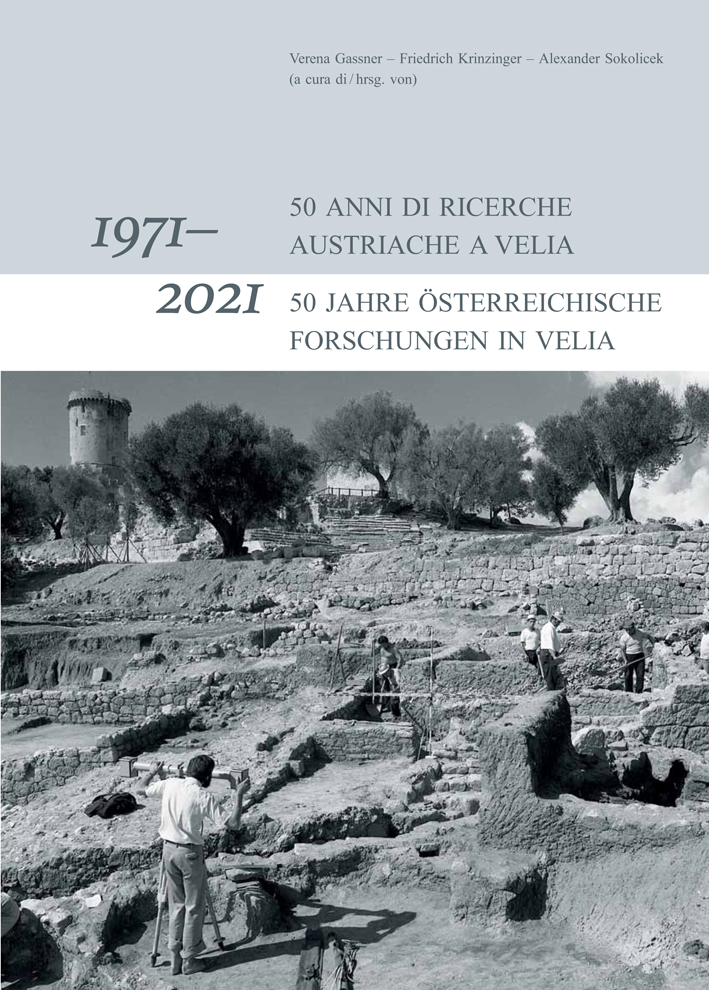Italy

Verena Gassner – Friedrich Krinzinger – Alexander Sokolicek (Hrsg. / a cura di),1971-2021: 50 anni di ricerche Austriache a Velia1971-2021: 50 Jahre Österreichische Forschungen in VeliaAtti del Convegno, Roma 16–18 settembre 2021, organizzato dall’Istituto Storico Austriaco e dal Forum Austriaco di cultura, insieme con l’Istituto d’Archeologia Classica, Università di ViennaAkten des Kongresses, Rom 16.–18. September 2021, organisiert vom Österreichischen Historischen Institut und dem Österreichischen Kulturforum gemeinsam mit dem Institut für Klassische Archäologie, Universität WienWien 2023ISBN 978-3-85161-285-1294 S./pp., zahlr. Farb- und S/W-Abb. / num. colour and b/w-figs., 29,7 x 21 cm; kartoniert / hardcoverAuch als E-Book erhältlich

Marco Galli – Tommaso Ismaelli,Basilica Iulia I. Gli Scavi di Laura Fabbrini (1960 - 1964)Strutture, Stratigrafie e Materiali dalla prima età Repubblicana alla Costruzione AugusteaIstanbul 2022ISBN 978-625-8056-42-6 XVIII + 563 S./pp., zahlr. Farb- und S/W-Abb./num. colour and b/w-figs., 33 x 24 cm; kartoniert/hardcover Texts in Italian with detailed English summaries / Testo italiano con ampi riassunti in inglese The volume presents the results of the Basilica Iulia Project, focused on the excavations conducted between 1960 and 1964 beneath the huge Augustan building. The archive documentation, new survey and geophysical prospecting, and the study of archaeological materials allow a thorough analysis of the transformations of the southern side of the Roman Forum between the 5th century BC and the modern rediscovery of the Basilica Iulia. The first part of the volume offers a vivid reconstruction of the administrative, political, and economic functions of the building during the imperial age and late antiquity. The research extends to the transformations of the medieval and Renaissance periods, focusing on the central role played by the Basilica Iulia in the history of the archaeological investigation of the Roman Forum. In the second part, the republican phases of the area beneath the Augustan monument are analysed. Significant new data concern the first occupation of the area in the 5th century BC, the mid-republican reorganisation of the district, with the creation of the house later belonged to Publius Cornelius Scipio Africanus, and the construction of the Basilica Sempronia (169 BC). New insights concern the connection between Caesar’s Basilica and the underground galleries of the Forum, and the construction site of the Augustan Basilica. Finally, the most innovative methods, from surveying to geophysical prospecting, are investigated in depth, along with the systematic study of the material culture, which is essential not only for defining the long diachrony of the area, but also for evaluating consumption and food practices. Il volume presenta i risultati del Progetto Basilica Iulia finalizzato alla pubblicazione degli scavi condotti tra 1960 e 1964 al di sotto del grande edificio augusteo. L’analisi della documentazione d’archivio, nuove campagne di rilievo e prospezioni geofisiche, lo studio dei materiali archeologi costituiscono la solida base per un’approfondita rilettura delle trasformazioni del lato meridionale del Foro Romano, tra il V sec. a.C. e la riscoperta della Basilica Iulia in età moderna. Nella prima parte del volume si ricostruisce un quadro delle funzioni amministrative, politiche ed economiche dell’edificio augusteo in età imperiale e tardo-antica. Lo sguardo si estende poi alle trasformazioni d’età medievale e rinascimentale, fino a evidenziare il ruolo centrale svolto della Basilica Iulia nella storia della ricerca archeologica nel Foro Romano. Nella seconda parte, si indagano le fasi più antiche del settore meridionale del Foro Romano. Significative novità riguardano la prima occupazione dell’area nel V sec. a.C., il profondo riassetto del quartiere nella media età repubblicana, con la creazione dell’abitazione poi appartenuta a Publio Cornelio Scipione Africano, e la realizzazione della Basilica Sempronia (169 a.C.). Della Basilica di Cesare si evidenzia il collegamento con le gallerie del Foro, mentre viene ricostruito l’imponente cantiere augusteo. Ampio spazio, infine, è dedicato agli approcci metodologici più innovativi, dal rilievo alle prospezioni geofisiche, così come alla discussione della cultura materiale, fondamentale per definire non solo le fasi di vita dell’area ma anche i consumi e le pratiche alimentari.

Michael Teichmann,Quantitative Untersuchungen zum römischen Siedlungswesen im südlichen Latium(Phoibos Humanities Series 7)Wien 2020ISBN 978-3-85161-228-8354 S. mit 109 Farbtaf., 29,7 x 21 cm; broschiertAuch als E-Book erhältlichKatalogdaten downloaden

Michael Teichmann,Mensch und Landschaft im südwestlichen Latium in der römischen Antike(Phoibos Humanities Series 6)Wien 2017ISBN 978-3-85161-171-7234 S. mit 58 Farbtaf., 29,7 x 21 cm; broschiert

Günther Schörner (Hrsg.),Leben auf dem Lande. 'Il Monte' bei San Gimignano: Ein römischer Fundplatz und sein KontextWien 2013ISBN 978-3-85161-092-5391 S., zahlr. Farb- und S/W-Abb., 29,7 x 21 cm; kartoniert

Wolfgang Wohlmayr,KaisersaalKultanlagen der Augustalen und munizipale Einrichtungen für das Herrscherhaus in Italienunveränderter NachdruckWien 2012ISBN 978-3-85161-056-7260 S., 138 S/W-Abb., 29,7 x 21 cm, broschiert

Dominik Maschek,Rationes decoris.Aufkommen und Verbreitung dorischer Friese in der mittelitalischen Architektur des 2. und 1. Jahrhunderts v. Chr.(Wiener Forschungen zur Archäologie 14) Wien 2012 ISBN 978-3-85161-083-3ISSN 1606-4712 374 S., 60 Taf., 29,7 x 21 cm; kartoniert Inhaltsverzeichnis 1. Vorwort 2. Abgrenzung des Themenbereichs 2.1. Vitruvs ratio decoris und die Legitimität rezeptionsästhetischer Ansätze in der Analyse spätrepublikanischer Bauornamentik 3. Prolegomena zur Methodik 3.1. Datensammlung, Typologie, Auswertung 3.2. Epistemologische Wurzeln und methodische Perspektiven 4. Dorische Friese in der mittelitalischen Architektur des 2. und 1. Jhs. v. Chr. 4.1. Forschungsgeschichte 4.2. Typologische Grundlagen Friesbegrenzung – Epistylgestaltung – Gebälkaufbau Elemente der Frieszone: Taeniae – regulae – guttae – Metopen, Triglyphen – capitula – lunulae Methodik der typologischen Analyse Metrologie Stilistische Beobachtungen 4.3. Typologische Analyse 1: Friesbegrenzung, Epistylgestaltung, architektonischer Kontext 4.4. Typologische Analyse 2: Friestypus, guttae, lunulae,Triglyphen; Motivik und Syntax des Metopendekors 4.5. Dorische Friese in der mittelitalischen Architektur des späten 2. und des 1. Jhs. v. Chr.: Synoptische Erklärungsmodelle für Verbreitung und Produktion 4.6. Abschließende Betrachtungen 4.6.1. Pietas erga deos. Zur Verwendung des dorischen Frieses in der mittelitalischen Sakral- und Sepulkralarchitektur des 2. und 1. Jhs. v. Chr. 4.6.2. „Haec mea sunt; veteres migrate coloni!“ – Auf der Suche nach den Veteranengräbern 4.6.3. Die rationes decoris: Handwerkstradition, gesellschaftliche Distinktion und dauerhafte Bedeutung Zusammenfassung Summary

Walter Paul Schussmann,Rhadamanthys in der Tomba del TuffatoreDas Grab des Mysten: eine NeuinterpretationWien 2011ISBN 978-3-85161-061-141 S., zahlr. Farbabb., 24 x 17 cm; broschiert
